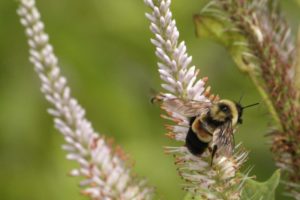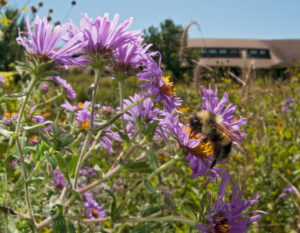
Bees have been in the news many times over the past several years. Much of the concern has been focused on the collapse of honey bee colonies because these bees collect nectar to create honey and can be transported for use as pollinators for farmers. Alongside the plight of the honey bee are the declines in the population of native bees in the United States. These bees include insects like the big, fuzzy bumble bees, tiny, iridescent green sweat bees and dark blue mason bees. The native bees live in different conditions. They may be solitary, have a small colony or even nest close together in a communal arrangement, but never in the numbers likely to be seen for a honey bee colony. These lower-density populations can make seeing a change in native bee numbers more difficult. While honey bees have gained the majority of bee decline attention, native bees have suffered dramatic population loss with long-term consequences for the plants they pollinate and the animals that depend upon those plants.
On January 11, 2017, in a landmark decision by the United States Fish and Wildlife Service, the one of the rarest native bees called the rusty-patched bumble bee (Bombus affinis) has been listed as threatened, and this designation will go into effect February 10, 2017. This is the first bee in the U.S. that has been placed on the Endangered Species list. The rusty-patched bumble bee derived its name from the rust-colored patch found on its back.
Why the Rusty-Patched Bumble Bee?
This species of bumble bee became the focus of attention by Clay Bolt, a nature photographer. His interest in native bees started with finding the insects in his own back yard in North Carolina and became a quest to photograph many of the 4,000 bees native to North America. He established a web site “Beautiful Bees” documenting his progress and sharing stories about the native bees he photographed.
Clay’s first encounter with Bombus affinis was in 2014. However, this was not with a live specimen but a pinned and preserved rusty-patched bumble bee in the collection at the Great Smoky Mountains National Park. Once the bumble bee was common in the area around the park, but as Clay Bolt shares on his web site, the range of the rusty-patched bumble bee has shrunk by 87% over the last 15 years. Even in the few areas the rusty-patched bumble bee remains, sighting the bee is rare.
The rusty-patched bumble bee was already the subject of a 2013 petition by the Xerces Society to be placed on the Endangered Species list. Clay was determined to find a living specimen to photograph and help tell the story of the rusty-patched bumble bee as a rallying point for trying to preserve the species.
This quest to photograph a living specimen of the rusty-patched bumble bee took the Clay Bolt to Madison, WI, specifically the University of Wisconsin–Madison Arboretum’s Curtis Prairie. There he was able to find living bees going about their business, pollinating flowers. In fact, he made a documentary film about the rusty-patch bumble bee called “A Ghost in the Making: Searching for the Rusty-Patched Bumble Bee”.

Now the efforts of the Xerces conservation society, Clay Bolt and his filmmaker partners, and the thousands of people who signed the petition to add the rusty-patched bumble bee to the Endangered Species List have borne fruit. Hopefully, the probable extinction of the once-common rusty-patched bumble bee can be halted and the first bee listed as an endangered species will be able to recover enough to be removed from this list. I plan on adding a few more native plants to my property and hopefully, benefit my native bees. Dare I dream maybe even attract a rusty-patched bumble bee to my flowers?
Sara Klink
Latest posts by Sara Klink (see all)
- A One-Two Punch to Knock Out HIV - September 28, 2021
- Toxicity Studies in Organoid Models: Developing an Alternative to Animal Testing - June 10, 2021
- Herd Immunity: What the Flock Are You Talking About? - May 10, 2021
